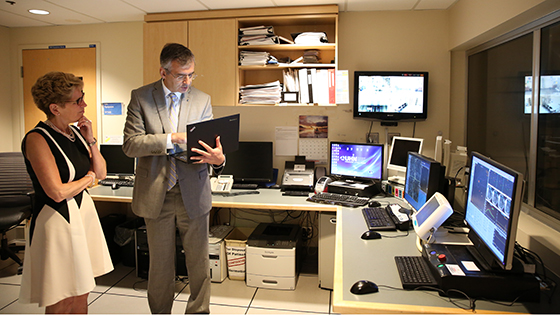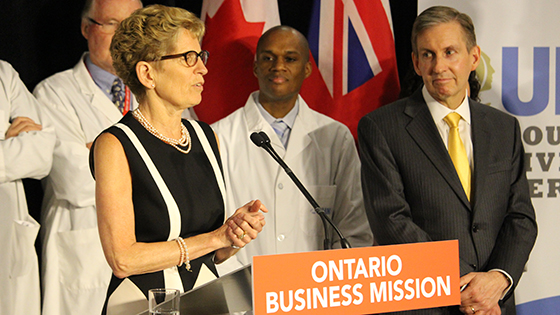
Dr. Andres Lozano, neurosurgeon, shows Premier Kathleen Wynne the control room of the Magnetic Resonance-guided Focused Ultrasound (MRgFUS) Lab where researchers are developing treatments for neurological disorders. (Photo: Jenna Muirhead-Gould)
Premier Kathleen Wynne visited Toronto Western Hospital on Tuesday to showcase an Ontario-Israel partnership that is bringing new technology to the province to treat neurological disorders, such as Parkinson's disease and essential tremor.
Accompanied by UHN CEO Dr. Peter Pisters and cardiologist Dr. Kenneth Melvin, the Premier was given a tour by neurosurgeon Dr. Andres Lozano of his Magnetic Resonance-guided Focused Ultrasound (MRgFUS) Lab.
The lab is benefiting from a $3 million Memorandum of Understanding, one of 44 agreements that were announced during Premier Wynne's mission to Israel and the West Bank last week and will position Ontario as a leader in focused ultrasound technology.
"This partnership is an exciting opportunity for Ontario to pursue new technology to help people suffering from neurological disorders," said Premier Wynne at a media availability following the tour.
In December 2012, Dr. Lozano and a team of co-investigators at Sunnybrook Health Sciences Centre were the first Canadian team to pioneer a procedure using MRgFUS to successfully treat patients with disabling tremors and the group published the world's first research paper on the subject.

Premier Kathleen Wynne and Dr. Peter Pisters, UHN President and CEO, at a news conference following Tuesday's announcement as scientists at Toronto Western Hospital look on. (Photo: UHN)
This outpatient procedure is described as "scalpel-free surgery" since there is no incision. There is no general anesthetic required, the patient remains awake and alert during treatment, and can go home the next day.
Similar to focusing the heat of the sun through a magnifying glass, the technology allows investigators to focus ultrasound waves under MRI guidance through a patient's skull to reach an area located deep in the brain.
Once that area has been located, the 1,024 focused ultrasound waves are delivered to a focal target over 10 seconds to destroy the neurons that are responsible for the tremor.
Since no incision is made and no device is implanted in the brain, there is no risk of bleeding in the brain or infection once the surgery is complete, greatly limiting the side-effects of the procedure.
"This partnership will greatly help UHN become a world leading centre to advance the MRgFUS technology research and treatment," said Dr. Lozano.
"As we develop novel technologies and perform clinical trials in this field, we hope to develop new indications for MRgFUS including treatments for pain, psychiatric disorders,epilepsy and brain tumours which will not only help thousands of patients in Ontario, but throughout the world."
